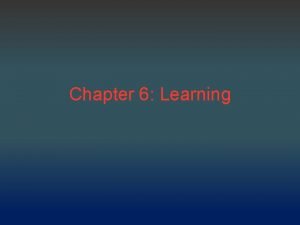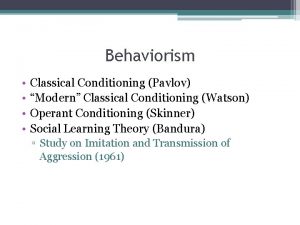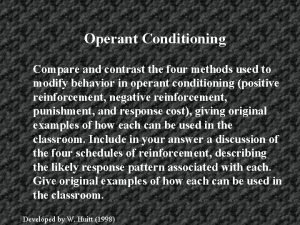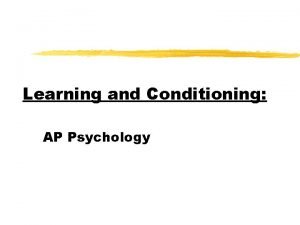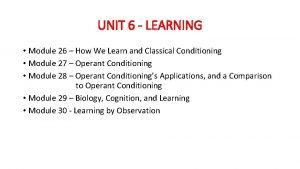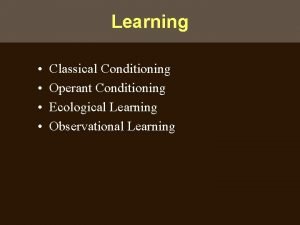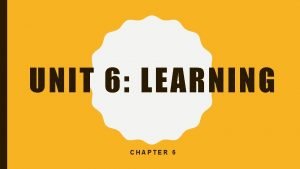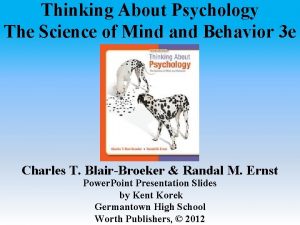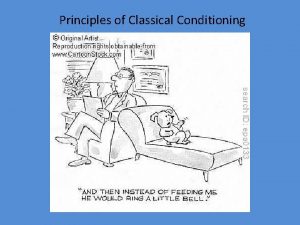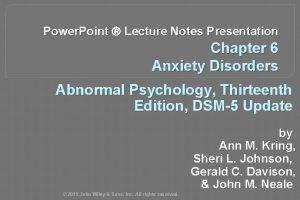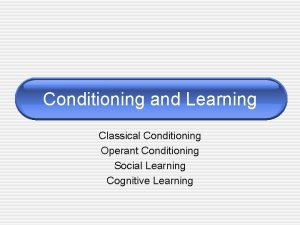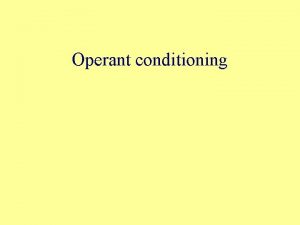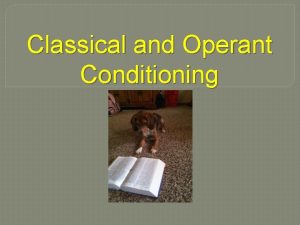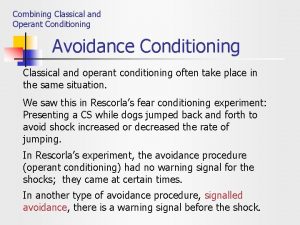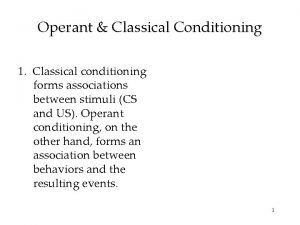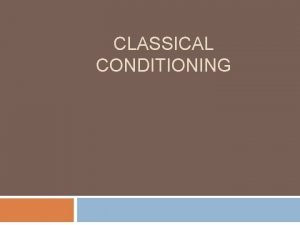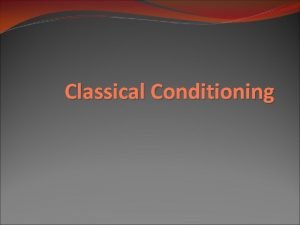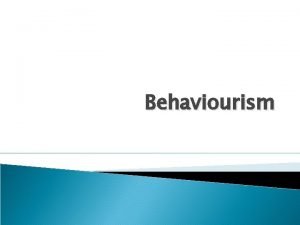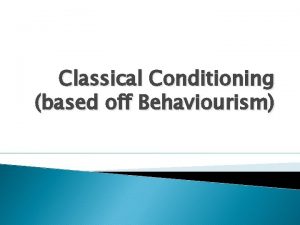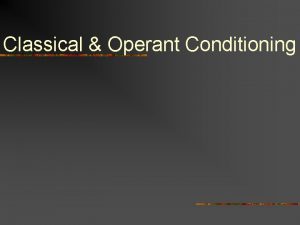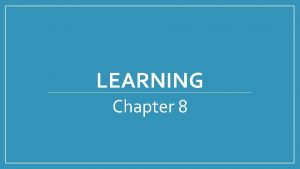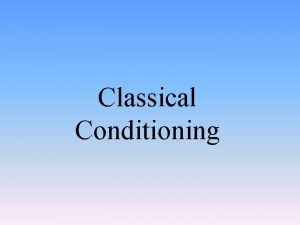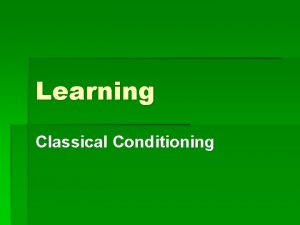Classical Conditioning EQ What is Classical Conditioning and



















- Slides: 19

Classical Conditioning: EQ: What is Classical Conditioning and how does it explain how we learn ? ? ?

III. Classical Conditioning • In classical conditioning, we are trying to elicit an involuntary response • This differs from operant conditioning in which a person makes a choice based on a reward or avoidance of punishment.

Terms to know • • • Unconditioned stimulus (UCS) Unconditioned response (UCR) Neutral stimulus (N) Conditioned stimulus (CS) Conditioned response (CR) • Get these from your textbook!

The Process of Classical Conditioning • UCS • N ==== + UCS UCR === UCR • With repeated pairings • • CS + UCS === CR CS ==== CR

El Capellon de la Virgen, Lope de Vega (1600 s) • Saint Ildefonso used to scold me and punish me lots of times. He would sit me on the bare floor and make me eat with the cats of the monastery. These cats were such rascals that they took advantage of my penitence. They drove me mad stealing my choicest morsels. It did no good to chase them away. But I found a way of coping with the beast in order to enjoy my meals when I was being punished.

• I put them in a sack and on a pitch black night I took them out under an arch. First I would cough and then whale the daylights out of the cats. They whined and shrieked like an infernal pipe organ. I would pause for a while and repeat the operation- first a cough and then a thrashing.

• I finally noticed that even without beating them, the beasts moaned and yelped like the very devil whenever I coughed. I then let them loose. Thereafter, whenever I had to eat off the floor, I would cast a look around. If an animal approached my food, all I had to do was to cough and how that cat did scat!

In the Story, what represents what? ? ? • UCS • N ==== + UCS UCR === UCR • With repeated pairings • • CS + UCS === CR CS ==== CR

IV. Pavlov and Classical Conditioning • Although Ivan Pavlov is credited with theory of Classical Conditioning, he was not the first person to publish on the Subject was E. B. Twitmyer • Twitmyer used the Patellar Tendon to prove theory. • Unfortunately, most people ignored his work.

IV. Pavlov and Classical Conditioning • In 1904, Russian Physiologist Ivan Pavlov won the Nobel Prize for his work on the digestive process of dogs. • While this was important work, it was the understanding of Classical Conditioning that really made Pavlov famous.

IV. Pavlov and Classical Conditioning • During his studies, Pavlov noticed that some dogs would salivate even when there was no food present • To test this, Pavlov used a neutral stimulus (a bell) in coordination with the unconditioned stimulus (meat powder) to get an unconditioned response (the dog drools)

IV. Pavlov and Classical Conditioning • To condition the dogs, Pavlov rang the bell just before feeding • Eventually, the dogs would drool when they heard the bell, even without the presence of the meat powder • They had been conditioned

Look at this. . . • • UCS ==== UCR Meat powder salivate N + UCS === UCR Tone Meat powder salivate With repeated pairings. . . CS + UCS === CR Tone Salivate


V. Acquisition • Involves repeated pairings of the CS and UCS to produce the CR

VI. Extinction • The gradual weakening and eventual disappearance of the CR • Involves repeatedly presenting the CS without pairing it with the UCS

VII. Spontaneous Recovery • Occurs when a previously extinguished CR suddenly reappears after a period of no training

VIII. Generalization • Occurs when stimuli similar to the CS produce a CR • The more similar the stimuli are to the CS, the greater the likelihood of generalization • Example?

IX. Discrimination • Occurs when stimuli similar to the CS do not produce a CR • The more similar the stimuli are to the CS, the greater the difficulty of discrimination
 Difference between operant and classical conditioning
Difference between operant and classical conditioning Classical vs operant conditioning
Classical vs operant conditioning Operant conditioning matrix
Operant conditioning matrix Classical conditioning vs operant
Classical conditioning vs operant Operant and classical conditioning
Operant and classical conditioning Skinner's schedules of reinforcement
Skinner's schedules of reinforcement Fixed interval schedule example
Fixed interval schedule example Fixed ratio schedule example
Fixed ratio schedule example Classical conditioning vs operant conditioning
Classical conditioning vs operant conditioning Operant conditioning classical conditioning
Operant conditioning classical conditioning Fixed interval schedule example
Fixed interval schedule example Difference between classical and operant conditioning
Difference between classical and operant conditioning How we learn and classical conditioning module 26
How we learn and classical conditioning module 26 Example of classical conditioning
Example of classical conditioning Classical conditioning examples
Classical conditioning examples Pavlovian response
Pavlovian response Order of classical conditioning
Order of classical conditioning Classical conditioning panic disorder
Classical conditioning panic disorder Contoh iklan classical conditioning
Contoh iklan classical conditioning Operant conditioning
Operant conditioning




